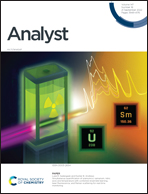Triphenylamine indanedione as an AIE-based molecular sensor with one-step facile synthesis toward viscosity detection of liquids†
Abstract
Viscosity is one of the most important physical parameters in a liquid, noninvasive, and effective viscosity inspection method toward liquid safety that needs to be developed urgently. In this study, two kinds of novel molecular sensors, namely, DPBID and DPTMID, were strategically constructed by the triphenylamine indanedione derivates; the rotatable conjugate structure was utilized as the recognition site and fluorescence quencher. This couple of molecular sensors was synthesized in a one-step facile manner. DPTMID displayed longer emission wavelength and larger Stokes shift (195 nm in water, 138 nm in glycerol) with a narrower energy band. Moreover, DPTMID exhibited high selectivity, sensitivity, and significant fluorescence signal enhancement toward a higher viscous microenvironment. The molecular sensor displayed good photostability, selectivity, and universality in various commercial liquids and featured with typical aggregation-induced emission (AIE). With the aid of DPTMID, the thickening effects of liquid thickeners can be captured. More importantly, DPTMID was explored to visualize the viscosity fluctuations during the metamorphic stages of liquids, and it was found that the microenvironment viscosity level is closely related to the spoilage degree of liquids. The method with rapid detection, high sensitivity, cheap equipment, and fast results output toward food quality and safety inspection can be achieved through this study.



 Please wait while we load your content...
Please wait while we load your content...